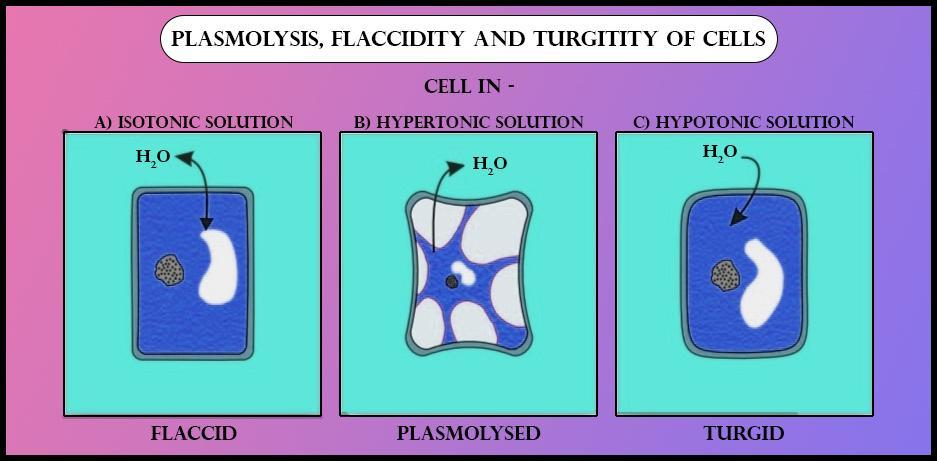
Plant cells are plasmolyzed in a solution, which is
a) Hypotonic solution
b) Hypertonic solution
c) Isotonic solution
d) None of the above
Answer
493.5k+ views
1 likes
Hint: Plasmolysis is a situation in which the contents of the cell shrink due to the presence of a higher concentration of the solutes outside the cells. The cytoplasm of the cell shrinks and detaches itself from the cell wall.
Complete answer:
Hypotonic solution is the solution that has a low concentration of the solutes present in it. The hypertonic solution is the one in which there is a high concentration of the solutes present. And in an isotonic solution, the amount of solutes present is equal to the solute’s concentration of the cell. When a cell is placed in a solution containing less concentration of the solution then the solutes from the solution tend to travel inside the cell.

This leads to the swelling of the cell. The cell wall applies a force in the opposite direction to prevent the cell from bursting. When the cell is placed in the hypertonic solution or in solution with high concentration of the solutes then the solutes from the cells move into the solution leading to the shrinkage of the cell cytoplasm. This condition of the cell is known as the plasmolyzed cell. When the cell is placed again from the hypertonic solution to the hypotonic solution then the cell is said to be plasmolysed. When a normal cell is placed in the isotonic solution then no change in the cell concentration is seen. Though there is some exchange of solutes which remains unnoticed.
So, the answer is ‘b) Hypertonic solution’.
Note: Plasmolysis is the condition in which the solutes move from the higher concentration to the lower concentration. It moves according to its surroundings concentration. Plasmolysis helps in the transportation of various solute particles.
Complete answer:
Hypotonic solution is the solution that has a low concentration of the solutes present in it. The hypertonic solution is the one in which there is a high concentration of the solutes present. And in an isotonic solution, the amount of solutes present is equal to the solute’s concentration of the cell. When a cell is placed in a solution containing less concentration of the solution then the solutes from the solution tend to travel inside the cell.

This leads to the swelling of the cell. The cell wall applies a force in the opposite direction to prevent the cell from bursting. When the cell is placed in the hypertonic solution or in solution with high concentration of the solutes then the solutes from the cells move into the solution leading to the shrinkage of the cell cytoplasm. This condition of the cell is known as the plasmolyzed cell. When the cell is placed again from the hypertonic solution to the hypotonic solution then the cell is said to be plasmolysed. When a normal cell is placed in the isotonic solution then no change in the cell concentration is seen. Though there is some exchange of solutes which remains unnoticed.
So, the answer is ‘b) Hypertonic solution’.
Note: Plasmolysis is the condition in which the solutes move from the higher concentration to the lower concentration. It moves according to its surroundings concentration. Plasmolysis helps in the transportation of various solute particles.
Latest Vedantu courses for you
Grade 11 Science PCM | CBSE | SCHOOL | English
CBSE (2025-26)
School Full course for CBSE students
₹41,848 per year
Recently Updated Pages
Master Class 11 Business Studies: Engaging Questions & Answers for Success

Master Class 11 Economics: Engaging Questions & Answers for Success

Master Class 11 Accountancy: Engaging Questions & Answers for Success

Master Class 11 Computer Science: Engaging Questions & Answers for Success

Master Class 11 English: Engaging Questions & Answers for Success

Master Class 11 Maths: Engaging Questions & Answers for Success

Trending doubts
The flightless birds Rhea Kiwi and Emu respectively class 11 biology CBSE

1 litre is equivalent to A 1000mL B 100cm3 C 10mL D class 11 physics CBSE

A car travels 100 km at a speed of 60 kmh and returns class 11 physics CBSE

Name the Largest and the Smallest Cell in the Human Body ?

Explain zero factorial class 11 maths CBSE

In tea plantations and hedge making gardeners trim class 11 biology CBSE




